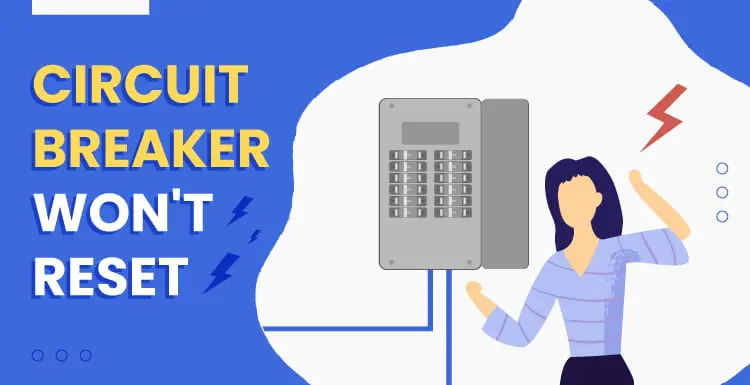Are you wondering why your circuit breaker won’t reset?
This is a common problem. But it can get dangerous very quickly.
We suggest you call an electrician, but if you have DIY experience, there are some things to try.
We partnered with Networx to help you find local electricians. Click to below to get a FREE quote.
Circuit Breaker Won’t Reset?
Did you notice that your tripped circuit breaker won’t reset?
We’ll help you determine the cause of your problem. After all, there are several reasons a circuit breaker won’t reset.
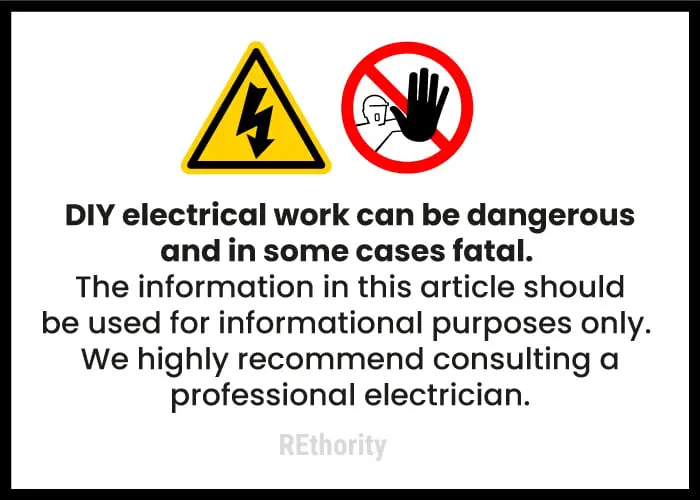
Some can indicate dangerous electrical problems.
In this article, we’ll explain:
- Different reasons your circuit breaker won’t reset
- When it may be safe to fix the problem
- And when to call a professional
But first, we need to get something out of the way. First, our guides are for informational purposes only.
We’re not licensed electricians, so we think you should always consult a professional. If you don’t take the right precautions, damage, fire, injury, or even death could result.
That said, in this article, we’ll explain the eight different reasons your breaker won’t reset, tips on when it may be safe to fix the problem yourself, and when to call a professional.
DIY vs Calling a Pro
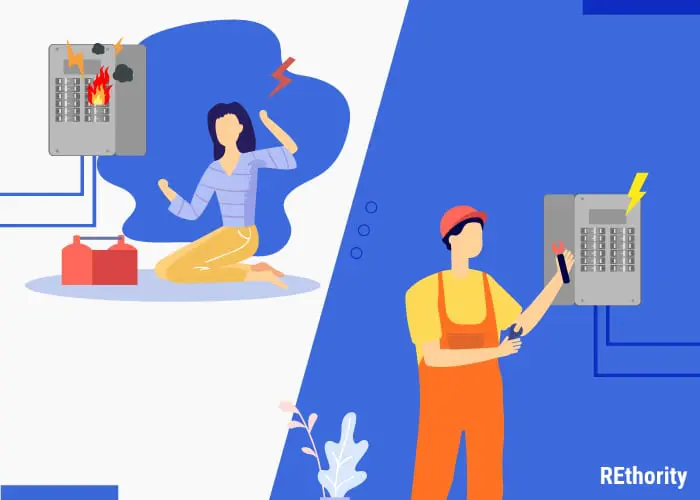
Even without advanced electrical knowledge and safety training, you may still be able to fix simple issues that lead to your circuit breaker failing to reset. Some of the underlying problems are more complex.
They may involve potentially dangerous contact with electrical wiring. These are the issues that will require a professional’s expertise. Again, messing with electricity without training is dangerous.
Whether you plan to fix it yourself or call a professional, it’s worth reading through the troubleshooting steps to learn about common ailments.
This way, if you call an electrician, you can provide them with additional information and get the problem fixed sooner. This will save the electrician time and you money.
Need a Local Electrician?
You probably don’t have a go-to electrician in your area. That’s understandable because, with any luck, you don’t need their services too often.
It does make it harder to find an electrician in the area when an electrical problem comes up, and you need someone to fix it fast.
That’s where we come in. Click here to describe the problem you’re having and get a free quote from a licensed electrician in your area right now!
Why Did the Circuit Breaker Trip in the First Place?
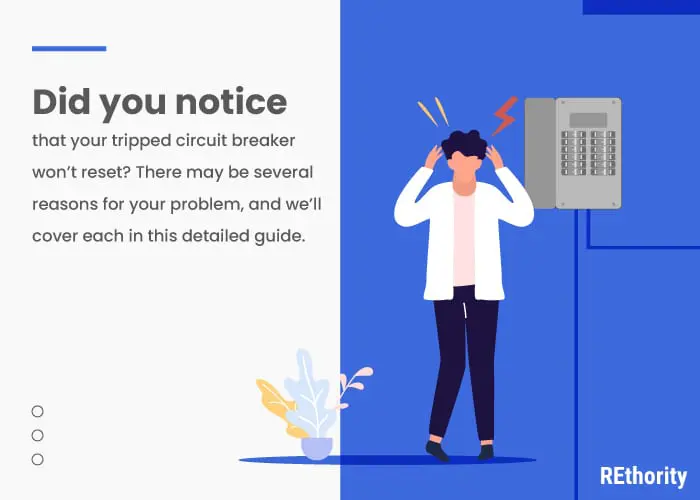
Circuit breakers are electrical safety devices for our protection. They ensure that the current moving through the wiring in our homes and buildings doesn’t rise to dangerous levels capable of causing overheating, property damage, or a fire.
Circuit breakers do this by limiting the current that passes through a circuit to an acceptable level. Current is measured in amperage.
The gauge, or size, of each circuit’s wiring decides how many amps and how much power will be safe to flow through that circuit.
Overloaded Circuits
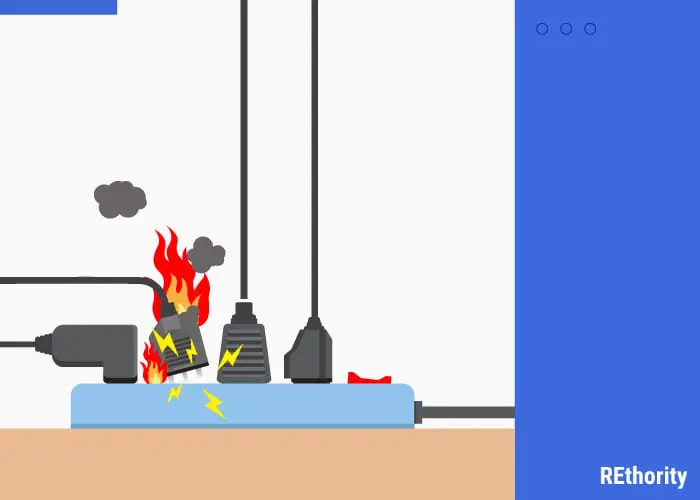
If too much electrical power flows through the wires in a circuit, the overload of electricity causes the circuit breaker to trip and break the circuit. This prevents additional damage from happening.
For example, most outlets and fixtures in a home are rated as either 15 amps or 20 amps.
- If the wire size used on a circuit is 14 gauge, it’s a 15 amp circuit. This means up to 15 amperes of current (1,800 watts) can safely flow through the outlets and fixtures on that circuit. Any more than 1,800 watts, and the circuit breaker will trip to break the circuit.
- If the wire size used on a circuit is 10 or 12 gauge, it’s a 20 amp circuit. This means up to 20 amperes of current (2,400 watts) can safely flow through the outlets and fixtures. Any more than 2,400 watts, and the circuit breaker will trip to break the circuit.
Anytime the number of watts (the measure of electrical power) being used goes above the circuit’s amp rating, the breaker will trip.
Here are some common reasons a breaker might trip:
- Plugging in too many devices or lights on one circuit
- Plugging in a device that pulls more power than you usually use (like power tools or a new TV)
- Connecting two or more extension cords to one circuit
- A short circuit creates a sudden spike the flow of current through a circuit
Once the circuit breaker trips, the circuit is broken. It must be manually reset to allow the current to flow again.
Circuit Breaker Won’t Reset: Troubleshooting the Problem
You’ll know that your circuit breaker has tripped if you suddenly lose power in part of your home. You might have experienced something like this:
You’re watching TV when it suddenly shuts off, along with nearby lights, ceiling fans, and everything else plugged in. You think that the circuit breaker has tripped, so you head to the electrical panel to reset the breaker.
You push the tripped switch into the off position, then back up into the on position to reset it. But the switch won’t stay in the on position, and the circuit breaker won’t reset.
Or it resets but trips again immediately. If something similar happened and you couldn’t reset the breaker, there are a few things that could be the culprit.
We’ll start with the simplest ones, then move on to problems that will require a professional’s help.
The Circuit Breaker Switch Isn’t Fully Off
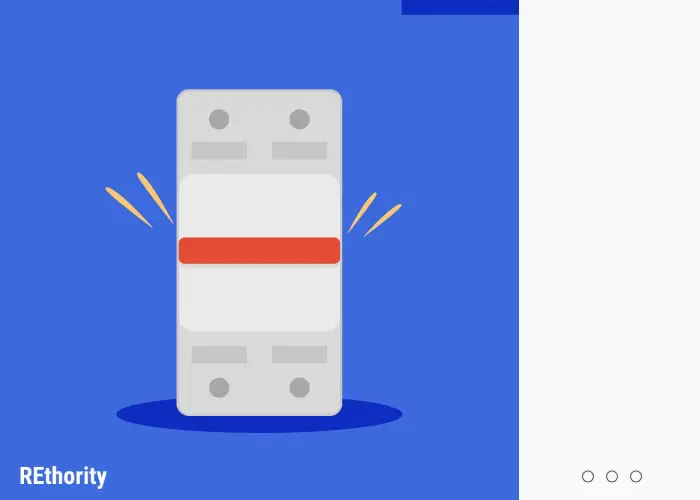
Be sure to click the tripped breaker switch into the off position firmly. From the tripped position, the switch has to move into the off position before it can be reset by switching it into the on position.
If you’ve been trying to push it into the on position without turning it off first, this could be the reason your circuit breaker won’t reset.
What you can do: Push the tripped switch back toward the off position until you hear a click. Push it forward to the on position.
If this was the extent of the problem, it should stay in the on position and not “bounce” back into the tripped position.
You Reset the Wrong Circuit Breaker Switch
Many times, the switches on circuit breakers will be labeled incorrectly or not at all. If it’s difficult to see your panel, you may have been resetting the wrong switch.
What you can do: With a flashlight, examine the switches to find one that looks like it’s not in line with the others. A tripped switch will look like it’s halfway between the on and off positions.
Remember to pull the switch back toward Off until you hear a click, then forward to On.
The Circuit Is Overloaded
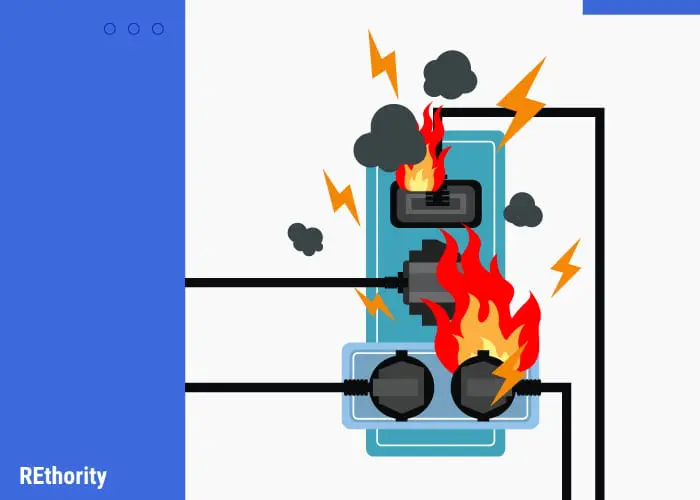
Circuits get overloaded when the electrical load is too high. Usually, this is due to too many devices or appliances being plugged in and using power.
It could also be due to a faulty appliance that is drawing more power than it should. You’ll know it’s an overloaded circuit if this happens:
- The breaker trips and you can’t get it to reset
- After letting it cool down for a few minutes, you’re able to reset it
- The breaker trips again a few minutes later
What you can do: If it is an overloaded circuit, it’s safe for you to fix yourself. Just unplug every device and appliance on that circuit, then try to reset the breaker again. If it works this time, you’ll know the circuit was just overloaded and throwing the switch.
As you plug devices back in one by one, see if an obvious culprit is drawing too much power. Try to move devices to other circuits to reduce the electrical load on the affected circuit as well.
There’s a Short Circuit
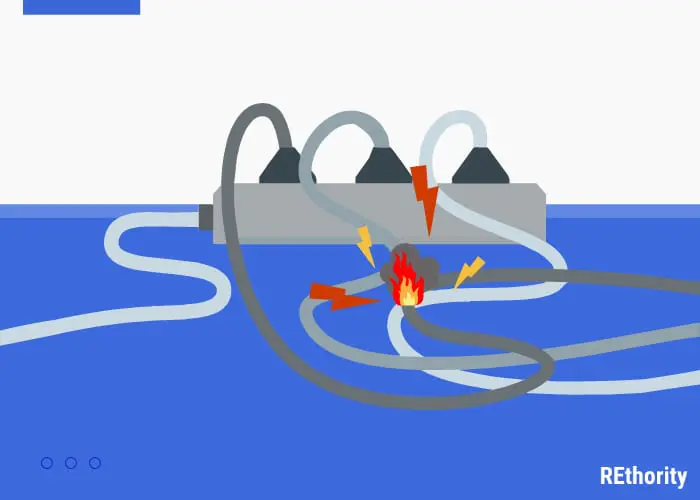
A short circuit happens when two electrical wires that aren’t supposed to touch come into contact. The electricity flowing through the wires surges and floods the circuit with additional current.
This trips the circuit breaker. Short circuits can happen in appliances, outlets, or switches. The wires touching in a short circuit may just be loose.
They could also be the result of damage from rodents or other animals chewing through them. It could be a short circuit if this happens:
- The breaker trips when you plug a certain appliance or device in
- It trips when you plug something into a certain outlet
- The breaker trips when you turn on a certain switch
- When you reset the breaker, it immediately trips again
What you can do: You’re going to need a professional for this one. Short circuits involve hot wires that have extremely high levels of current flowing through them. This presents a huge risk of getting shocked.
However, you can get an idea of the short circuit’s location (appliance, outlet, or switch) with a few simple tests before the electrician or appliance repair technician arrives.
- If there’s an appliance you suspect may have a short, try plugging it into a different outlet. If it immediately trips the breaker, you’ll know the appliance is the problem. Unplug it immediately, and don’t use any appliances with a short. An electrician or appliance repair technician will need to fix the problem.
- If a certain outlet seems to be the short-circuit location, try plugging something into the outlet to see if it trips the breaker. An immediate trip would indicate the short is in the outlet. Unplug the device, and don’t touch the outlet. An electrician will need to fix the problem.
- If you think a switch is where the short is, flip it on again to see if it trips the breaker. If it does, you’ve found the problem. Flip the switch off and don’t use it until an electrician can repair the problem.
Faulty or Blown Circuit Breaker
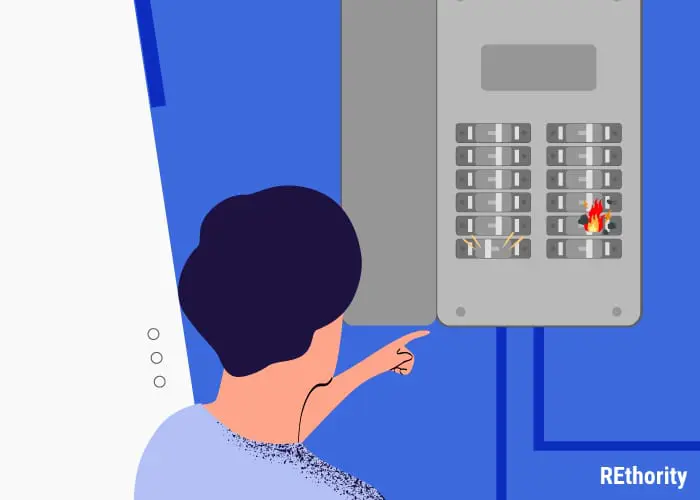
A faulty or blown circuit breaker can cause a switch to stay in the tripped position no matter which way you push it. It’s not usually the culprit when a circuit breaker won’t reset.
But it’s such a serious problem that it’s worth having an electrician come to inspect just in case. Your circuit breaker is a safety mechanism to protect you and your home from damage from electrical problems.
One that’s not operating correctly isn’t offering protection. You might suspect a faulty or blown circuit breaker if:
- You push the tripped breaker switch toward the Off position firmly
- It springs back to the middle-tripped position
What to do: Call an electrician right away. Your circuit breaker will probably need to be replaced. You are at increased risk for damaged wiring, appliances, and electrical fires without a properly working circuit breaker.
Whatever you do, never replace the circuit breaker with one that has a higher voltage rating. These breakers can cause the wiring in your home to overheat, which could cause a fire.
Other Reasons a Circuit Breaker Won’t Reset
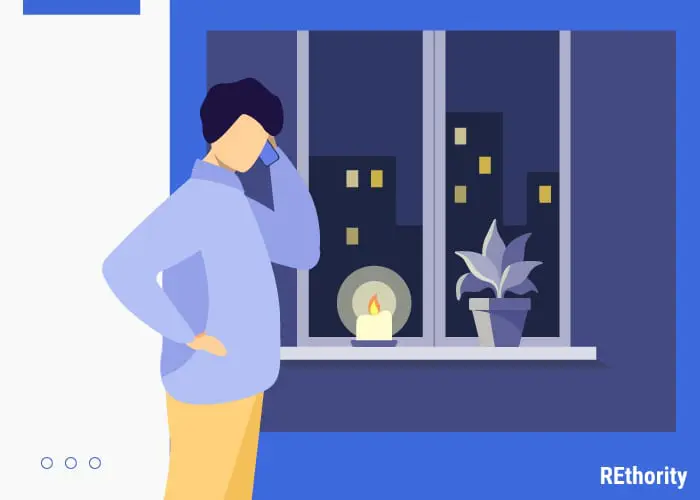
- Open ground: Outlets and wires have an “open ground” when a wire isn’t correctly grounded. It usually happens when a wire is disconnected on one end, and it will affect all the outlets connected from that point in the house. This is a type of short circuit and is very dangerous, so call an electrician immediately to fix it.
- The electrical overload in the circuit is still there. If you failed to unplug appliances and devices from outlets using the circuit that tripped the breaker, the electrical overload is still there. It may prevent you from resetting the breaker, so unplug those appliances and devices and try to reset them again.
- GFCI (Ground Fault Circuit Interrupter) wasn’t reset. Circuits that have a GFCI need to be reset either individually or in the main electrical panel. Unplug any devices from GFCI outlets (they have Test and Reset buttons) and then push Reset. Some electrical panels have a GFCI breaker switch that usually features a test button. If resetting the outlets doesn’t fix the problem, try resetting the GFCI breaker switch.
Frequently Asked Questions
How do you fix a circuit breaker that won’t reset?
If your circuit breaker won't reset, push the tripped switch back toward the Off position until you hear a click.
Push it forward to the On position. If that doesn't work, with a flashlight, examine the switches to find one that looks like it’s not in line with the others. A tripped switch will look like it’s halfway between the On and Off positions.
If it is an overloaded circuit, it’s safe for you to fix yourself. Just unplug every device and appliance on that circuit, then try to reset the breaker again.
If it works this time, you’ll know the circuit was just overloaded and throwing the switch.
How do you reset a stuck circuit breaker?
To reset a stuck circuit breaker, turn it all the way off and then back on.
If it trips again, your circuit may be shorting out or it might be overloaded. In that case, call an electrician immediately.
What are the signs of a bad circuit breaker?
A few signs of a bad circuit breaker include flickering or blinking lights, poor performance of appliances, the need to regularly replace light bulbs, and smelling a burning odor from your electrical panel.
Under what condition might the circuit breaker not reset?
The most common reason a circuit breaker wouldn't reset is due to an overloaded or faulty circuit. However, both of these issues should be fixed by a licensed electrician.
Can a breaker be bad but not tripped?
Yes. A circuit breaker can be bad but not tripped. This needs to be fixed immediately, as a circuit breaker that doesn't trip could lead to an electrical panel fire.
Why Would a Circuit Breaker Stay Trip?
The most common cause of a circuit breaker tripping and staying tripped is overloaded circuits. If your breaker continues to stumble or stays tripped, you may need to shut the breaker off and back on, fully resetting it.
You might also have to shut off your appliances to give the breaker a chance to clear.
Alternatively, a breaker that stays tripped might be short-circuited or blown.
A blown circuit is likely to feel warm to the touch and won’t stay in reset mode. It might also have visible damage or a burning smell. At this point, your breaker will not reset on its own.
This means that your breaker will need the assistance of a qualified electrician to resume working.
How Do You Know if a Circuit Breaker is Blown?
There are several ways to tell if your circuit breaker is blown.
First, it may be blown if your breaker doesn’t stay in “reset” mode. If you notice a burning smell, that is not a good sign and may signal a short circuit.
You can feel the breaker to see if it is hot to the touch, and if you notice damage to the box or outlets, you may have a short-circuit situation on your hands.
Lastly, if your breaker is old, consider replacing it since old breakers are more likely to give out.
We partnered with Networx to help you find local electricians. Click to below to get a FREE quote.
When a Circuit Breaker Won’t Reset, Put Safety First
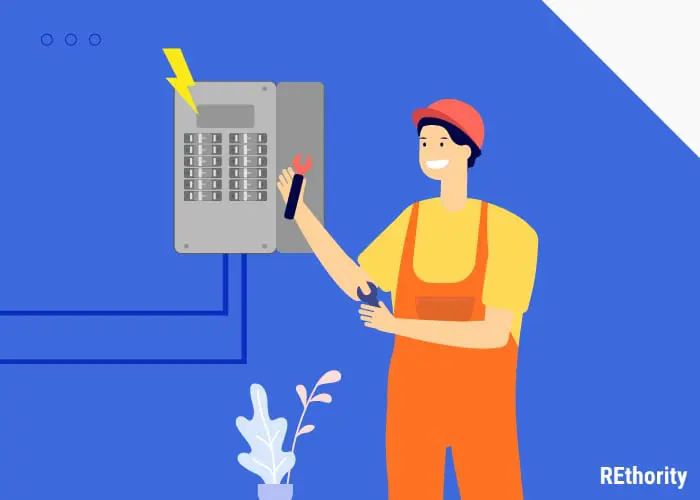
Some issues around the house are easy to fix without help, but anything involving electricity just isn’t worth the risk. If your circuit breaker won’t reset, there are two things you should do.
First, double-check to make sure you’ve tried to reset the breaker switch correctly (and that you’re resetting the right one). Then, unplug any devices and appliances from an outlet you think may be overloaded.
Don’t mess with suspected short circuits, faulty breakers, or ground faults at all. Just call a licensed electrician. They can help with any of the issues we’ve covered in this troubleshooting guide.
And they know how to do it safely and to code. Electrical issues should be addressed right away. Click the button above to get a free quote from a qualified, licensed professional near you today.

